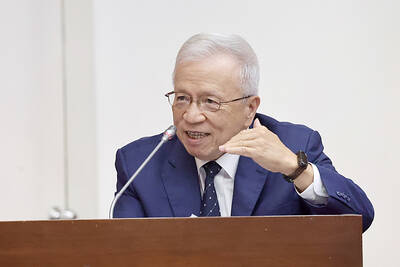Taiwan does not have the “Dutch disease,” Minister of Finance Su Jain-rong (蘇建榮) said yesterday, referring to an overreliance on a temporarily surging sector at the cost of other industries.
The government supports a variety of sectors, not just the semiconductor industry, whose development “does not harm other sectors,” he said.
Su’s comments came after opposition lawmakers said that Taiwan has become overly reliant on a few tech firms, while non-tech manufacturing sectors are declining.

Photo: CNA
The term “Dutch disease” was coined in 1977 by The Economist to describe the decline of the Dutch manufacturing sector after the discovery of the large Groningen natural gas field in 1959.
The Netherlands posted annual trade surpluses from 1970 to 1980 on the back of natural gas exports, which drove up the country’s currency and led to manufacturers becoming less competitive internationally, with many eventually moving their production abroad.
Lawmakers said the local economy is comparable to the Netherlands at the time.
Taiwan’s “small and open” economy is taking a similar development as the European country, with increasing reliance on chip exports, and profitability and wages in the chip sector and other industries increasingly diverging, they said.
Su dismissed the comparison, saying the government has sought to promote the “five plus two” industries by developing Taiwan into a regional technology hub, shoring up local firms that supply smart machinery, and developing green energy sources, biomedicine and national defense.
President Tsai Ing-wen (蔡英文) is seeking to establish a new agricultural model and a circular economy, Su said.
Local semiconductor firms command global leadership positions, but small and medium-sized firms in other sectors also contribute significantly to GDP growth and employ many people, he said.
The central bank has said that Taiwan’s non-tech manufacturers, such as suppliers of plastic and chemical products, remain competitive, although they generate less added value than local tech firms.
Local makers of steel products, bicycles and vehicle parts have gained significant global market shares, the central bank said.
However, non-tech manufacturers lag behind tech firms in terms of wages, but that is due to supply and demand in the job market, rather than resource distribution or currency movements, it said.
Local electronics suppliers have benefitted from a work-from-home boom during the COVID-19 pandemic and global supply chains moving away from China, the central bank said.

JITTERS: Nexperia has a 20 percent market share for chips powering simpler features such as window controls, and changing supply chains could take years European carmakers are looking into ways to scratch components made with parts from China, spooked by deepening geopolitical spats playing out through chipmaker Nexperia BV and Beijing’s export controls on rare earths. To protect operations from trade ructions, several automakers are pushing major suppliers to find permanent alternatives to Chinese semiconductors, people familiar with the matter said. The industry is considering broader changes to its supply chain to adapt to shifting geopolitics, Europe’s main suppliers lobby CLEPA head Matthias Zink said. “We had some indications already — questions like: ‘How can you supply me without this dependency on China?’” Zink, who also

At least US$50 million for the freedom of an Emirati sheikh: That is the king’s ransom paid two weeks ago to militants linked to al-Qaeda who are pushing to topple the Malian government and impose Islamic law. Alongside a crippling fuel blockade, the Group for the Support of Islam and Muslims (JNIM) has made kidnapping wealthy foreigners for a ransom a pillar of its strategy of “economic jihad.” Its goal: Oust the junta, which has struggled to contain Mali’s decade-long insurgency since taking power following back-to-back coups in 2020 and 2021, by scaring away investors and paralyzing the west African country’s economy.

Taiwan Semiconductor Manufacturing Co (TSMC, 台積電) received about NT$147 billion (US$4.71 billion) in subsidies from the US, Japanese, German and Chinese governments over the past two years for its global expansion. Financial data compiled by the world’s largest contract chipmaker showed the company secured NT$4.77 billion in subsidies from the governments in the third quarter, bringing the total for the first three quarters of the year to about NT$71.9 billion. Along with the NT$75.16 billion in financial aid TSMC received last year, the chipmaker obtained NT$147 billion in subsidies in almost two years, the data showed. The subsidies received by its subsidiaries —

BUST FEARS: While a KMT legislator asked if an AI bubble could affect Taiwan, the DGBAS minister said the sector appears on track to continue growing The local property market has cooled down moderately following a series of credit control measures designed to contain speculation, the central bank said yesterday, while remaining tight-lipped about potential rule relaxations. Lawmakers in a meeting of the legislature’s Finance Committee voiced concerns to central bank officials that the credit control measures have adversely affected the government’s tax income and small and medium-sized property developers, with limited positive effects. Housing prices have been climbing since 2016, even when the central bank imposed its first set of control measures in 2020, Chinese Nationalist Party (KMT) Legislator Lo Ting-wei (羅廷瑋) said. “Since the second half of